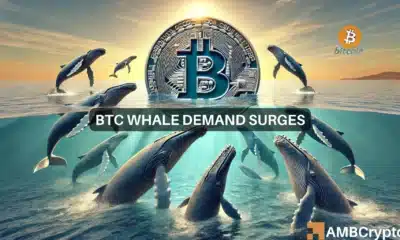Increase yield earning opportunities with Bunicorn

Over the last year, the high-performance Binance Smart Chain has rapidly overtaken Ethereum as the leading platform for decentralized finance (DeFi) applications. The tremendous innovation in automated market-making that has taken place on Ethereum, as the de facto chain for projects seeking smart contract functionality for many years, is following close behind.
Bunicorn saw no reason to reinvent the wheel but instead chose to improve it. Bunicorn combines the best of several AMM models to create a DEX with liquidity pools that provide high capital efficiency and low slippage. These optimized pools additionally benefit from the high speed and low gas fees of the Binance Smart Chain.
What is Bunicorn?
Bunicorn is a decentralized exchange (DEX) on the Binance Smart Chain (BSC) network offering investors yield-earning opportunities through liquidity pools and liquidity farm mining with unique time-locked rewards wrapped into tradable NFTs.
The automated market maker (AMM) protocol has designed liquidity pools that reduce risks and improve capital inefficiencies prevalent in popular AMM models like Uniswap and PancakeSwap. Two highly capital efficient liquidity pool models are offered through one seamless interface:
- Flexible pools with up to 8 tokens, with any weight (Balancer-style)
- Stable pools with super low slippage and high capital efficiency for stablecoins (Kyber DMM-style)
Additionally, to minimize price depreciation caused by liquidity providers immediately selling off rewards, Bunicorn offers high APY liquidity mining farms with a novel NFT reward vesting model.
Why Do We Need a New AMM Model for the Binance Smart Chain?
Owing to the high price volatility in cryptocurrencies, liquidity providers (LPs) using the most popular AMMs like Uniswap or PancakeSwap have high exposure to two types of price risk: impermanent loss and slippage. Impermanent loss occurs when any profit from a change in the price of an asset deposited into a 50/50 liquidity pool (e.g., ETH/DAI) is removed by arbitrageurs, who profit from trading on the price discrepancies until the market price and pool price are in equilibrium.
Wide price fluctuations also increase slippage — the difference between the quoted and execution price. To reduce the risk of impermanent loss, LPs are required to make large capital expenditures to add tokens to the pool to maintain equal value in the cryptocurrency pair. Since most AMMs only offer fixed token weightings (typically 50/50) and fee models regardless of the market volatility, few other options for improving liquidity are available. This issue becomes worse when you want to swap between stablecoins because their price is meant to be stable.
Three Optimized AMM Models Reducing Liquidity Risks
AMMs have introduced diverse approaches to lower the risk of impermanent loss and high slippage on Ethereum. Curve reduces these price risks by using similarly priced assets (e.g., stablecoins or wrapped Bitcoin). Because these assets are more highly correlated, price volatility is minimized.
Balancer offers pools with eight tokens and arbitrary weights. When an LP chooses to maintain a higher weight in certain assets (say 80/20), less capital is required to add tokens in higher weighted tokens to maintain the equal value of the tokens.
Kyber DMM introduced its highly capital efficient Dynamic Market Maker (DMM) in April. Kyber DMM uses amplified pools with dynamic fees that increase or decrease in periods of high or low volatility, respectively, according to an AMP factor. In this way, the DMM optimizes returns by reducing volatility.
The Bunicorn Solution for BSC
Bunicorn’s solution to reducing the high capital requirements of current AMMs is to combine the Balancer and Kyber DMM models into a single seamless UI that addresses all of the problems above with the following features:
Balancer-style Flexible AMM pools for swapping between standard BEP20 tokens with a customizable number of assets and arbitrary weights within a pool to lower the risk of impermanent loss.
Kyber-style Amplified pools that allow swapping between stablecoins with lower slippage and higher capital efficiency.
Liquidity providers have the option of joining multi-token pools with a single asset. Smart order routing can automatically split a swap across several pools for optimized pricing.
What Are the Advantages of Bunicorn Flexible Pools?
Bunicorn Flexible pools can contain two or more tokens (up to eight), each with an independent weight representing its proportion of the total pool value.
There are two types of Bunicorn Flexible pools: Shared pools and Smart pools.
Shared Pool
Shared pools are “public” flexible pools whose parameters are fixed. Anyone can add or remove liquidity and swap tokens in the pools.
Smart Pool – The Liquidity Bootstrapping Pool
Bunicorn is bringing the Balancer-style liquidity bootstrapping pool (BBP) to the Binance Smart Chain. The pools have been specially designed to distribute tokens fairly and bootstrap liquidity in token launches, both weaknesses of current AMM models.
The Smart pool is a highly flexible pool allowing the creator to change settings at any time, including token weightings, swap fees, and the stop and start of trading.
What Are the Advantages of Bunicorn Stable Pools?
Bunicorn Stable pools are customized for stablecoin trading, with the following advantages:
- Amplified pools with high capital efficiency. LPs can adjust the pricing curves of any stablecoin pair using a special amplification factor known as ‘AMP.’ Whenever there is a change in token numbers in the pool, AMP will dynamically adjust and amplify the balance to improve liquidity and slippage.
- Lower trade slippage due to high capital efficiency.
- Dynamic fees to optimize returns for liquidity providers, adjusted based on market conditions to maximize returns for liquidity providers and reduce the impact of impermanent loss.
Bunicorn Liquidity Mining With Wrapped NFTs
LPs can increase their yield-making potential on Bunicorn by adding tokens to liquidity mining pools. In exchange for providing liquidity, LPs are rewarded with additional tokens.
Each liquidity provider receives fees proportional to their share of overall tokens in the pool. The annual returns (APY) are typically representative of the risk of a pool. However, another liquidity risk is raised for tokens when LPs immediately sell their token rewards. Also, a high APY yield farming program introduces a higher inflation rate of the token supply.
Bunicorn reduces these token price devaluation risks by locking up farming rewards in wrapped NFTs to take them out of circulation. These NFTs continue to provide value including trading opportunities to liquidity miners.
What Are Wrapped NFTs?
Bunicorn has introduced a new liquidity mining model by wrapping up farming rewards (VBUNI) into NFT collectibles. Users can then use these NFTs to convert VBUNI into the actual BUNI tokens after a vesting period. In the meantime, they can also trade/auction these NFTs in other well-known marketplaces and make them liquidable.
How Can Yield Farm NFTs Increase Yields?
The NFTs as collectibles can be ascribed additional value. Bunicorn will rank the rarity of the NFT collectibles based on the number of underlying assets wrapped in that token. For instance, a $1M BUNI token could be considered Ultra Rare or Super Rare. Separately, the wrapped NFTs can have collectibles value as works of art. Bunicorn will also generate tailored-made designs, a unique algorithmically generated Bunny character, similar to that of Crypto Kitties or Polkamons.
A major advantage of Bunicorn’s yield farm NFT is that it contains actual time-locked tokens similar to a bond. In other words, it contains speculative value. If an LM does not want to wait until the vesting period to end, he can sell his NFT at a discount. Besides, a Super Rare asset could be bought or sold at a price much higher than the underlying BUNI value in other NFT markets. Therefore, with the wrapped reward NFTs, Bunicorn achieves two goals: separating the BUNI tokens from the circulating supply but still making them liquidable in the form of NFT assets.
Who benefits from Bunicorn?
By fixing the problems of existing AMM on BSC and reduce the inflation rate of liquidity mining models on NFTs, Bunicorn brings up use-cases that will benefit a wide range of users:
- Liquidity providers who have cryptocurrencies sitting idle in their wallet and would like to earn passive income from swapping fees and liquidity mining.
- Token teams who want to distribute their token via a fair Liquidity Bootstrapping Pool distribution model. Bunicorn can also be used as an alternative to a normal DEX listing with higher flexibility because users can customize the weight of their pool for example 70% Token, 30% BNB.
- Retail users who want to swap tokens with low slippage and good price.
- Whales who want to convert their stablecoin from one to another, or want to make the best profit out of their large stablecoin portfolio.
- Arbitrageurs who exploit market inefficiencies between exchanges to earn profit.
- Other Defi products seek liquidity through smart contracts ABI.
- NFT collectors/traders who want to benefit from our ultra-rare and limited value-locked NFT collectibles.
What’s next with Bunicorn?
In the short term, the Bunicorn team is building its own NFT marketplace for its value-locked NFT collectibles. It will also allow normal NFTs to be minted/traded with additional time-locked fungible tokens. This new generation of value-backed NFTs re-define its value and change how we see them from normal artworks to valuable assets with speculative price. It opens new doors for collectors, traders, and content-creator worldwide.
Another ongoing work stream is the Bunicorn’s mobile app. Most of the DEXs right now are web-based applications while the mobile app users have dominated the CEXs for years. Therefore, Bunicorn wants to make our DEX to a wider range of users through the touch of their fingers.
The Bunicorn team is working on its governance system with the primary goals to have more utilities for the BUNI token and incentives for its holders. Once it is completed, a portion of the revenue from swapping fees and NFT trades will be distributed to BUNI holders. The rest will be used to buy back and burn the BUNI tokens.
Disclaimer: This is a paid post and should not be treated as news/advice.






